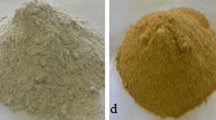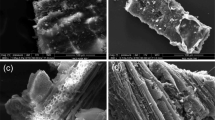Abstract
Background
Arsenic (As) availability in natural environment is related to the element’s adsorption and desorption processes in soils. Total As is better related to available As in temperate soils than in tropical soils. In tropical soils, total As is not very significant in terms of availability, therefore justifying the necessity for studies into As dynamics. Knowledge of As dynamics in soil as well as development of new analytical methodologies involving tropical soils are insufficient and necessary for future mitigation projects.
Objective
The objectives of this study were: (1) To adjust methodologies which may assist in understanding arsenate dynamics in tropical soils and substrates; (2) To evaluate the adsorption and desorption of arsenate in soils and substrate samples, and to find a minimum value of arsenate available in soil which is lethal to sorghum plants.
Material and Methods
Samples of three soils from Minas Gerais State (YL, RYL, and CS) and two sulfide substrates of gold mining (B1 and B2) were used in the assays. All the material was physically and chemically characterized. Remaining As (As-rem) and remaining P (P-rem) of each material, along with MACP and MACAs (using the Langmuir isotherms), were obtained. After agitation to obtain MACP and MACAs, arsenate was extracted by anionic resin and Mehlich-III to evaluate arsenate desorption of the material retained on the filter paper. Subsequently, arsenate desorption curves for the different materials were obtained, and arsenate availability was determined through a bioassay with sorghum plants. Samples of soils and substrate B1 were incubated with six levels of As doses. Plants were grown under greenhouse conditions for 30 days. The plants were then harvested, dried and weighed. Available As in the soils and substrate was determined by Mehlich-III.
Results and Discussions
As-rem level decreased from YL (sandy) to RYL (clayey) soil samples, which always showed lower values than P-rem. Among the soils and substrates evaluated, RYL showed the highest MACAs and MACP, followed by CS, YL and Bl. The results were in accordance with the values observed for As-rem and P-rem and confirm the idea that the ability of the assayed materials to remove As from the soil/substrate solution is higher than the ability to remove P. On the other hand, the binding energy (a) between soil/substrate and As is weaker than the binding energy of P. Given the fact that the studied soils present a real ability to remove As from the solution, only a small part of As would be unavailable considering MACAs as a reference. As-Mehlich-III values were higher than As-resin for substrate Bl. Mehlich-III seemed to be more appropriate to extract labile forms of arsenate in substrate B1 as well as in the soils. Available As by Mehlich-III (26.9 mg/dm3) was considered a reference of As LCL to sorghum plants. CC50 was sensitive to the buffering capacity of each soil, showing values varying from 1.34 mg/dm3 As (clay soil with lower As-rem) to 12.31 mg/dm3 As (sandy soil with higher As-rem).
Conclusions
The adaptation of the As-rem and MACAs methodologies was satisfactory and of great value in the study of adsorption, desorption and As availability for soils and mining substrate. Mehlich-III was also satisfactory to estimate available As and was sensitive to soil buffering capacity. Nevertheless, resin can also be used as an alternative. MACAs varied among soils and was higher than MACp. However, As showed higher lability than P. Using Mehlich-III, we determined the value corresponding to CC50 that showed a good reference of toxicity to available As.
Outlook
The environmental implications of the As behavior are quite serious. Beside the fact that arsenate is removed very fast from the soil solution, an anthropogenic input of the element, being part of the soil quantity factor, may remain in a reversible form for a long time. As may therefore return to the soil solution and becomes available to plants, animals and the entire environment. Considering that CC50 is the maximum contents of available As the environment can tolerate to allow some vegetal biomass production, the maximum capacity of As immobilization in each soil is reduced when compared to the soils’ MACAs values. Therefore, the maximum and safe values of reference to be used in the evaluation of incidental discharge of the element in soils must be reduced.
Similar content being viewed by others
Abbreviations
- MACAs :
-
maximum adsorption capacity of arsenate
- MACP :
-
maximum adsorption capacity of P
- LCL:
-
lethal critical level
- CC50:
-
50% critical content
- P-rem:
-
amount of added P which remains in equilibrium solution after a defined time of contact with soil
- As-rem:
-
amount of added As which remains in equilibrium solution after a defined time of contact with soil
- YL:
-
Yellow Latosol from João Pinheiro
- RYL:
-
Red-Yellow Latosol from Paracatu
- CS:
-
Cambisoil from Paracatu
References
Alvarez V VH (1988): Enxofre: critérios de diagnose para o solo e planta, correção de deficiência e excessos. In: Borkert CM, Lantmann AF (Eds): Enxofre e micronutrientes na agricultura brasileira. Londrina, PR, EMBRAPA-CNPS/IAPAR/SBCS, pp 31-59
Alvarez V VH, Dias LE (1996): Enxofre. Fertilidade e manejo do solo. Brasília: ABEAS/UFV, 100 pp
Alvarez V VH, Dias LE, Ribeiro Jr ES, Souza RB, Fonseca CA (2001): Métodos de análises de enxofre em solos e plantas. Editora UFV. Universidade Federai de Vi ç osa, Brasil, 131 pp
Braga JH, Defelipo BV (1974): Determina ç ão espectrofotométrica do fósforo em extrato de solos e plantas. Rev Ceres 21, 73–85
Daniel AM (2000): Avalia ção preliminar do potencial de gera ção de águas ácidas por atividades minerárias no Estado de Minas Gerais. MS, Universidade Federal de Viçosa, Brasil, 93 pp
Defelipo BV, Ribeiro AC (1981): Análise química do solo (Metodologia). Editora UFV, Universidade Federai de Viçosa, Brasil, 17 pp
Deschamps E (2003): Avalia ção da contaminação humana e ambiental por arsênio e sua imobilização em hidróxidos e óxidos de ferro e manganês. DS, Universidade Federal de Minas Gerais/CPGEM, Brasil, 133 pp
Embrapa (1997): Manual de métodos de análise de solo. Rio de Janeiro, Centro Nacional de Pesquisa de Solos, Brasil, 212 pp
Fordham AW, Norrish K (1979): Arsenate uptake by components of several acid soils and its implication for phosphate retention. Austr J Soil Res 17, 307–316
Fowler BA (1980): Toxicology of environmental arsenic. In: Goyer RA, Mehlman MA (eds): Advances in Modern Toxicology – Toxicology of trace elements. Hemisphere Publishing Corporation, Vol 2, pp 79-121
Fuller CC, Davis JA, Waychunas GA (1993): Surface chemistry of ferrihydrite Part 2: Kinetics of arsenate adsorption and coprecipitation. Geochim Cosmochim Acta 57, 2271–2282
Gunnars A, Blomqvist S, Johansson P, Andersson C (2002): Formation of Fe(III) oxyhydroxide colloids in freshwater and brackish seawater, with incorporation of phosphate and calcium. Geochim Cosmochim Acta 66, 745–758
Huang J, Goltz D, Smith F (1988): A microwave dissolution technique for the determination of arsenic in soils. Talanta 35, 907–908
Huang PM (1975): Retention of arsenic by hydroxi-aluminum on surface of micaceous mineral colloids. Soil Sci Soc Am J 39, 271–274
Livesey NT, Huang PM (1981): Adsorption of arsenate by soils and its relation to selected chemical properties and anions. Soil Science 131, 88–94
Manning BA, Suarez DL (2000): Modeling Arsenic(III) adsorption and heterogeneous oxidation kinetics in soil. Soil Sci Soc Am J 64, 128–137
Masscheleyn PM, Deluane RD, Patrick WH (1991): Effect of redox potential and pH on arsenic speciation and solubility in a contaminated soil. Environ Sci Technol 25, 1414–1419
McGeehan SL, Naylor DV (1994): Sorption and redox transformation of arsenite and arsenate in two flooded soils. Soil Sci Soc Am J 58, 337–342
Novais RF, Smyth TJ (1999): Fósforo em solo e planta em condições tropicais. DPS/UFV, Viçosa-MG, Brasil, 399 pp
Oscarson DW, Huang PM, Liaw WK, Hammer UT (1983): Kinetics of oxidation of arsenite by various manganese dioxides. Soil Sci Soc Am J 47, 644–648
Parfitt RL (1978): Anion adsorption by soils and soil materials. Adv Agron 30, 1–50
Pierce ML, Moore CB (1982): Adsorption of arsenite and arsenate on amorphous iron hydroxide. Water Res 16, 1247–1253
Ribeiro Jr ES (2003): Adsorção e dessor ção de arsênio em solos e substratos de minera ção de ouro e práticas de mitigação de drenagem ácida em colunas de lixiviação. DS, Universidade Federal de Viçosa, Brasil, 117 pp
Smedley PL, Kinniburgh DG (2002): A review of the source, behaviour and distribution of arsenic in natural waters. Applied Geochemistry 17, 517–568
Sun X, Doner HE (1998): Adsorption and oxidation of arsenite on goethite Soil Sci 163, 278–287
Waltham CA, Eick MJ (2002): Kinetics of arsenic adsorption on goethite in the presence of sorbed silicic acid. Soil Sci Soc Am J 66, 818–825
Author information
Authors and Affiliations
Corresponding author
Rights and permissions
About this article
Cite this article
Ribeiro, E.S., Dias, L.E., Alvarez, V.H.V. et al. Adsorption and Desorption of Arsenate in Different Soils and Gold Mining Substrates of Minas Gerais State, Brazil. J Soils & Sediments 4, 163–169 (2004). https://doi.org/10.1007/BF02991134
Received:
Accepted:
Issue Date:
DOI: https://doi.org/10.1007/BF02991134




